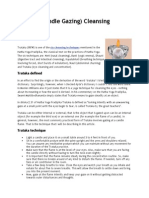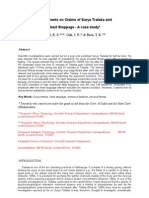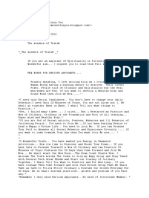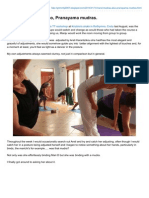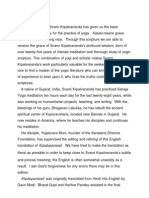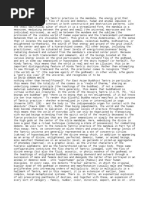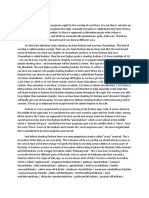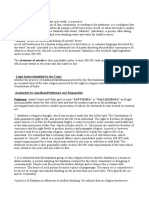Tratak
Tratak
Uploaded by
Shamik ChowdhuryCopyright:
Available Formats
Tratak
Tratak
Uploaded by
Shamik ChowdhuryOriginal Description:
Copyright
Available Formats
Share this document
Did you find this document useful?
Is this content inappropriate?
Copyright:
Available Formats
Tratak
Tratak
Uploaded by
Shamik ChowdhuryCopyright:
Available Formats
Yoga - SECRETS OF TRATAK SADHANA
by Acharya Shree Dhruv
Dhotirvastistatha Netishtratkam Nowlikam Tatha Kapalbhatischetani Khastkarmani Prachate Hathayog Pradipika
According to Hathayog Pradipika, there are six types of hathayoga: dhauti, vasti, neti, nauli, tratak and kapalbhati. These are all yogic processes (shat karma) which apart from imparting physical and mentalpeace also provide spiritual power. The first four, i.e., dhauti, vasti, neti and nauli are related to purification of the body, while the last two, tratak and kapalbhati, are related to spiritual achievements. How does tratak sadhana affect us The flow of thoughts in our brain is an on-going process. Due to this, 80 per cent of our energy is wasted and our central nerve system loses its balance. But when we attain tratak sadhana, gradually we start experiencing peace of mind, and thereafter we start getting rid of unwanted thoughts. With this process we start gaining more and more energy. And a time comes when we are able to perform an unusual feat. But what is tratak sadhana? It is defined as focusing your attention with concentration on a point or on the flame of a lamp continuously, without blinking. Three types of tratak sadhana (a) Inner tratak Sadhana (b) Middle tratak sadhana (c) Outer tratak sadhana Inner tratak sadhana is closing the eyes and focusing your attention on the middle of your forehead, where Lord Shivas third eye is located. In the beginning you may feel some pain or heat in your head but do not worry, as it will normalise gradually. Try to keep your entire attention on this point. Benefits: With this yogic action you can hypnotise any person who is very far from you. It will also help in building your confidence, intelligence and patience. It will even take away negative thoughts and desires from your mind and will give you peace.In Middle tratak sadhana, focus your eyes and attention on either the flame of a lamp (which is lit by the oil of black sesame) or on a crystal shivlinga. If you get a burning sensation in your eyes, close your eyes for some time and then again repeat this kriya (process). For this kriya, keep the lamp or shivlinga at a distance of 20 inches at eye level so that there is no strain or pressure on your neck. Benefits: Improves concentration, memory and mental power. Besides, you get foresight, hypnotic and spiritual power. It also increases your working efficiency and the ability to read others' mind. Outer tartak sadhna can be performed at anytime of the day or night, by focusing your eyes and attention on any object like the sun, moon, stars. Those who have a weak eyesight cannot perform this. Benefits: Helps in getting rid of mental disorders and improves motivational power and foresight.
Do suksham pranayam before practising tratak because this sadhana requires mental peace. If your mind is not peaceful or comfortable, you cannot be successful. With suksham pranayama you can control your mind. Rules of suksham pranayama: Sit in sukhasan without any body movement and take in and release long deep breaths slowly. This has to be done for 21 days regularly for 15 minutes a day. It will be better to start trarak sadhana after this. For tratak sadhana: 1. Sit on a blanket in sukhasna or sidhasna and keep back, neck and spine straight. 2. Keep negative thoughts and lust away from your mind. 3. Do tratak with dedication, patience and concentration. 4. Always practise in a closed room and be by yourself. 5. It is effective if practised at a fixed place and time. 6. Out of the three ways of practising tratak, choose the one with which you feel comfortable. 7. Try to spend more or equal time in this sadhana as you spend on the first day. 8. Leave all addictions. 9. Those suffering from tuberculosis, heart diseases, leprosy and eye diseases should not practise tratak. 10. While practising, do not move your body. Sit like a statue. 11. Practice after taking bath and wear loose clothes, preferably white. 12. Choose any one of three kriyas and practice it continuously for three months.
You might also like
- SAP EDI, IDOC, and Interfacing Interview Questions, Answers, and ExplanationsDocument233 pagesSAP EDI, IDOC, and Interfacing Interview Questions, Answers, and ExplanationsRamalakshmi Somasundaram100% (1)
- Trataka Intelligence Memory Super BainDocument14 pagesTrataka Intelligence Memory Super BainSreeraj Guruvayoor S67% (3)
- Philip Corso Dawn of A New AgeDocument176 pagesPhilip Corso Dawn of A New AgeI am that I am67% (3)
- Kapalabhati Pranayama or Breath of FireDocument6 pagesKapalabhati Pranayama or Breath of Firemsayee100% (1)
- Invoke The Shadow MenDocument10 pagesInvoke The Shadow MenBen Winter100% (3)
- Sadhguru ZitateDocument2 pagesSadhguru ZitateShamik ChowdhuryNo ratings yet
- Sadhguru ZitateDocument2 pagesSadhguru ZitateShamik ChowdhuryNo ratings yet
- Techniques of Kriya YogaDocument64 pagesTechniques of Kriya Yoga2gangadhara100% (14)
- Tratak Se Dhyan Ki orDocument4 pagesTratak Se Dhyan Ki orPawan MadanNo ratings yet
- Trataka Intelligence MemoryDocument3 pagesTrataka Intelligence MemorySreeraj Guruvayoor S100% (1)
- Benefits of Tratak SadhanaDocument11 pagesBenefits of Tratak Sadhanafeeamali1445100% (3)
- Trataka Intelligence Brain Power GeniusDocument7 pagesTrataka Intelligence Brain Power GeniusSreeraj Guruvayoor SNo ratings yet
- Antar Tratak Meditation and Drishti YogaDocument6 pagesAntar Tratak Meditation and Drishti YogaAnurag Chand67% (3)
- Tratak SadhanaDocument5 pagesTratak SadhanaVishwanath Joshi100% (1)
- Experiments On Claims of Surya Trataka andDocument9 pagesExperiments On Claims of Surya Trataka andNikki*No ratings yet
- Sushumna, Awakens or Opens UpDocument5 pagesSushumna, Awakens or Opens UpMaggie MaviNo ratings yet
- Mudras For Women in Enhancing The Level of Oomph - A Pilot Trial in VirudhunagarDocument5 pagesMudras For Women in Enhancing The Level of Oomph - A Pilot Trial in VirudhunagarinventionjournalsNo ratings yet
- Durga 32 NamesDocument1 pageDurga 32 Namessayan biswasNo ratings yet
- Trataka MeditationDocument3 pagesTrataka Meditationaghorishiva100% (1)
- Most Powerful Mantra For Opening 3rd Eye ChakraDocument16 pagesMost Powerful Mantra For Opening 3rd Eye Chakrawobblegobble100% (3)
- FREE - Tratak Meditation An Introduction and Benefits PDFDocument6 pagesFREE - Tratak Meditation An Introduction and Benefits PDFnit528No ratings yet
- Transmit Ion of Spiritual Power EngDocument8 pagesTransmit Ion of Spiritual Power EngAnderson SmithNo ratings yet
- Satsang of Shri DevDas Ji Maharaj DelhiDocument2 pagesSatsang of Shri DevDas Ji Maharaj DelhiPranay KumarNo ratings yet
- Primordial Sound Meditation Beej Beeja Bija Mantra MantrasDocument6 pagesPrimordial Sound Meditation Beej Beeja Bija Mantra Mantrasimvav100% (1)
- Kriya For ProsperityDocument3 pagesKriya For ProsperityCara CulerNo ratings yet
- On Early RiseDocument14 pagesOn Early RiseArseniy Plagov100% (1)
- FAQsDocument11 pagesFAQsThiru ArasuNo ratings yet
- Course Material Part-2Document224 pagesCourse Material Part-2pranav_joshi_32No ratings yet
- Breath PranayamaDocument10 pagesBreath Pranayamasonaliforex1100% (2)
- The Divine Power Within You The Wonders of TratakDocument31 pagesThe Divine Power Within You The Wonders of TratakDusko BjelicNo ratings yet
- Third Eye AwakeningDocument3 pagesThird Eye Awakeningramadx123100% (2)
- Trataka The Meditation of Third EyeDocument5 pagesTrataka The Meditation of Third Eyefire_n_ice100% (1)
- Ajna ChakraDocument3 pagesAjna ChakranieotyagiNo ratings yet
- How To Chant and Various Methods of ChantingDocument10 pagesHow To Chant and Various Methods of ChantingPatrick KongNo ratings yet
- What Is A BijamantraDocument14 pagesWhat Is A BijamantraanshuaaNo ratings yet
- MantrasDocument4 pagesMantrasnandkishor joshiNo ratings yet
- The Twenty-Four SiddhisDocument1 pageThe Twenty-Four Siddhisvinod kumar mishra0% (1)
- From Sex Energy To Energy: SpiritualDocument1 pageFrom Sex Energy To Energy: SpiritualvineethNo ratings yet
- Mantra PDFDocument25 pagesMantra PDFSanju SatheeshNo ratings yet
- Aatma AavahanDocument2 pagesAatma AavahanGurvinder Kabir Singh100% (1)
- Swar YogaDocument2 pagesSwar Yogasun1986No ratings yet
- Nadis - Sanjeevini Spiritual Healing Center PDFDocument11 pagesNadis - Sanjeevini Spiritual Healing Center PDFElio BermejoNo ratings yet
- Kundalini Activation Using PranayamaDocument21 pagesKundalini Activation Using PranayamaStephen SequeiraNo ratings yet
- Trata KamDocument11 pagesTrata KamPaul Travis0% (1)
- Analysis of Frequency Dependent Vedic Chanting and Its Influence On Neural Activity of HumansDocument10 pagesAnalysis of Frequency Dependent Vedic Chanting and Its Influence On Neural Activity of HumansIJRES teamNo ratings yet
- Breathing For Psychic PowerDocument1 pageBreathing For Psychic Powermysticdream100% (4)
- Simple Mudra PractiseDocument7 pagesSimple Mudra PractiseramaneeshNo ratings yet
- Meditation - To Tap Opportunities: (Yoga For Prosperity, Siri Kirpal Kaur Khalsa, Pp. 68-69.)Document3 pagesMeditation - To Tap Opportunities: (Yoga For Prosperity, Siri Kirpal Kaur Khalsa, Pp. 68-69.)Hazel Aikulola Griffith100% (1)
- The Practice of TratakaDocument9 pagesThe Practice of TratakaDusko Bjelic100% (1)
- KripalupanishadDocument47 pagesKripalupanishadhari haraNo ratings yet
- Meditation For A Calm HeartDocument1 pageMeditation For A Calm HeartGabriela Garcia ToledoNo ratings yet
- Spiritual HealingDocument11 pagesSpiritual HealingLizelMostertNo ratings yet
- Mantras For Astral Projection 3Document2 pagesMantras For Astral Projection 3SIGILS MANIFESTATIONNo ratings yet
- Kumbhak PranayamDocument3 pagesKumbhak PranayamRohitUpadhyayNo ratings yet
- Kundalini by GurudevDocument15 pagesKundalini by GurudevVikash AggarwalNo ratings yet
- Sun Moon MeditationDocument1 pageSun Moon MeditationgholamoseinNo ratings yet
- Gayatri MantraDocument2 pagesGayatri MantrapassinetNo ratings yet
- Life RegenerationDocument2 pagesLife Regenerationmarduk20140% (1)
- TextDocument8 pagesTextvenusmavelikaraNo ratings yet
- Saral MeditationDocument4 pagesSaral MeditationGeorge finkleNo ratings yet
- Mantras For Astral Projection 4Document2 pagesMantras For Astral Projection 4SIGILS MANIFESTATION100% (1)
- Healing with Angel Talk: Learn How Your Angels Can Help You Heal Your Mind, Body and Soul!From EverandHealing with Angel Talk: Learn How Your Angels Can Help You Heal Your Mind, Body and Soul!No ratings yet
- Vestige Cruise Invitation 17 TH FebruaryDocument3 pagesVestige Cruise Invitation 17 TH FebruaryShamik ChowdhuryNo ratings yet
- Every Particle in Your Body Is Communicating With The Entire Cosmos. Yoga Is About Experiencing ThatDocument1 pageEvery Particle in Your Body Is Communicating With The Entire Cosmos. Yoga Is About Experiencing ThatShamik ChowdhuryNo ratings yet
- Suomi DemographicsDocument44 pagesSuomi DemographicsShamik ChowdhuryNo ratings yet
- 1 Variant Configuration Final Draft 06apr08 OverviewDocument41 pages1 Variant Configuration Final Draft 06apr08 OverviewShamik ChowdhuryNo ratings yet
- Sap Press Catalog q3 2013Document32 pagesSap Press Catalog q3 2013Hidayat AliNo ratings yet
- Microsoft Word Shortcut KeysDocument3 pagesMicrosoft Word Shortcut KeysShamik ChowdhuryNo ratings yet
- SAP SD Interview Questions Answers and Explanations Espana No RestrictionDocument129 pagesSAP SD Interview Questions Answers and Explanations Espana No Restrictionkhaleel_salam40% (5)
- The SecretDocument65 pagesThe SecretShamik ChowdhuryNo ratings yet
- The Mind and It's ControlDocument51 pagesThe Mind and It's ControlShamik Chowdhury67% (3)
- ABC Textile India LTDDocument207 pagesABC Textile India LTDShamik ChowdhuryNo ratings yet
- ABC Textile India LTDDocument207 pagesABC Textile India LTDShamik ChowdhuryNo ratings yet
- Indian History PDFDocument32 pagesIndian History PDFakritiNo ratings yet
- YamantakaDocument2 pagesYamantakanieotyagiNo ratings yet
- Art and CultureDocument100 pagesArt and Cultureyawerahmad052100% (1)
- Harimī Estotram (Śa Karācāryaviracitam)Document6 pagesHarimī Estotram (Śa Karācāryaviracitam)HariHaraNo ratings yet
- Tantric MandalaDocument4 pagesTantric MandalaYugal ShresthaNo ratings yet
- The Mystery of Venus in Pisces Marriage Life ColorDocument11 pagesThe Mystery of Venus in Pisces Marriage Life Colorravvhi100% (1)
- A Simple Method To Abide in The - I AmDocument5 pagesA Simple Method To Abide in The - I AmvedaprakashmNo ratings yet
- Lao Tzu: Shermetova Bermet & Mamadjanova FatimaDocument18 pagesLao Tzu: Shermetova Bermet & Mamadjanova FatimaBlue NightNo ratings yet
- Core An Manual Orph 00 Scot RichDocument290 pagesCore An Manual Orph 00 Scot RichUmar PodoNo ratings yet
- Awake - To The Call of ISLAAM 1431Document129 pagesAwake - To The Call of ISLAAM 1431_abd_No ratings yet
- Maruti StotraDocument5 pagesMaruti StotraPradnya JoshiNo ratings yet
- Iwrbs Q2 M9Document13 pagesIwrbs Q2 M9James Jacob PaltepNo ratings yet
- A Life Interwoven With GayatriDocument417 pagesA Life Interwoven With GayatriAcharya BalwantNo ratings yet
- Hemi - Sync Basics: Stimulating The BrainDocument7 pagesHemi - Sync Basics: Stimulating The Brainzexpader100% (1)
- Parvati ShivaDocument4 pagesParvati Shivaapi-3746563100% (2)
- Siddhashram Gyanganj.Document32 pagesSiddhashram Gyanganj.Shobha HadimaniNo ratings yet
- Gist of Sri Rudram PlusDocument32 pagesGist of Sri Rudram PlusRakesh Singh100% (1)
- Devatha Hastha NotesDocument4 pagesDevatha Hastha NotesUmaparvathy KaliappanNo ratings yet
- Legal Issues Identified by The CourtDocument5 pagesLegal Issues Identified by The CourtKrishna NathNo ratings yet
- G K and Most Important QuestionsDocument7 pagesG K and Most Important QuestionssurenNo ratings yet
- Specifications of Hindu MonotheismDocument46 pagesSpecifications of Hindu MonotheismPrasennajeet NehamaiyahNo ratings yet
- Tummo Practice by Ngawang ChodakDocument6 pagesTummo Practice by Ngawang ChodakJVernonNo ratings yet
- Bhakti - Sufi TraditionsDocument8 pagesBhakti - Sufi TraditionsAshutosh GiriNo ratings yet
- Application of Vipassana in Daily LifeDocument49 pagesApplication of Vipassana in Daily Lifeapi-3817018100% (1)
- Buddhist Missionaires in The Era of GlobalizationDocument256 pagesBuddhist Missionaires in The Era of GlobalizationDamith ChandimalNo ratings yet
- Abhisamayalamkara ResumsDocument10 pagesAbhisamayalamkara ResumstotfemNo ratings yet
- Buddhism and The Business World The Buddhist Way To Deal With BusinessDocument79 pagesBuddhism and The Business World The Buddhist Way To Deal With BusinessMai Dinh Phuong100% (1)
- The Beginner's Guide To Starting A Yoga PracticeDocument343 pagesThe Beginner's Guide To Starting A Yoga PracticeSara Velez Barrientos100% (3)
- Lalla-Mystic Poet of Kashmir: Dr. Jaishree KakDocument7 pagesLalla-Mystic Poet of Kashmir: Dr. Jaishree Kaksuwari yatiNo ratings yet









